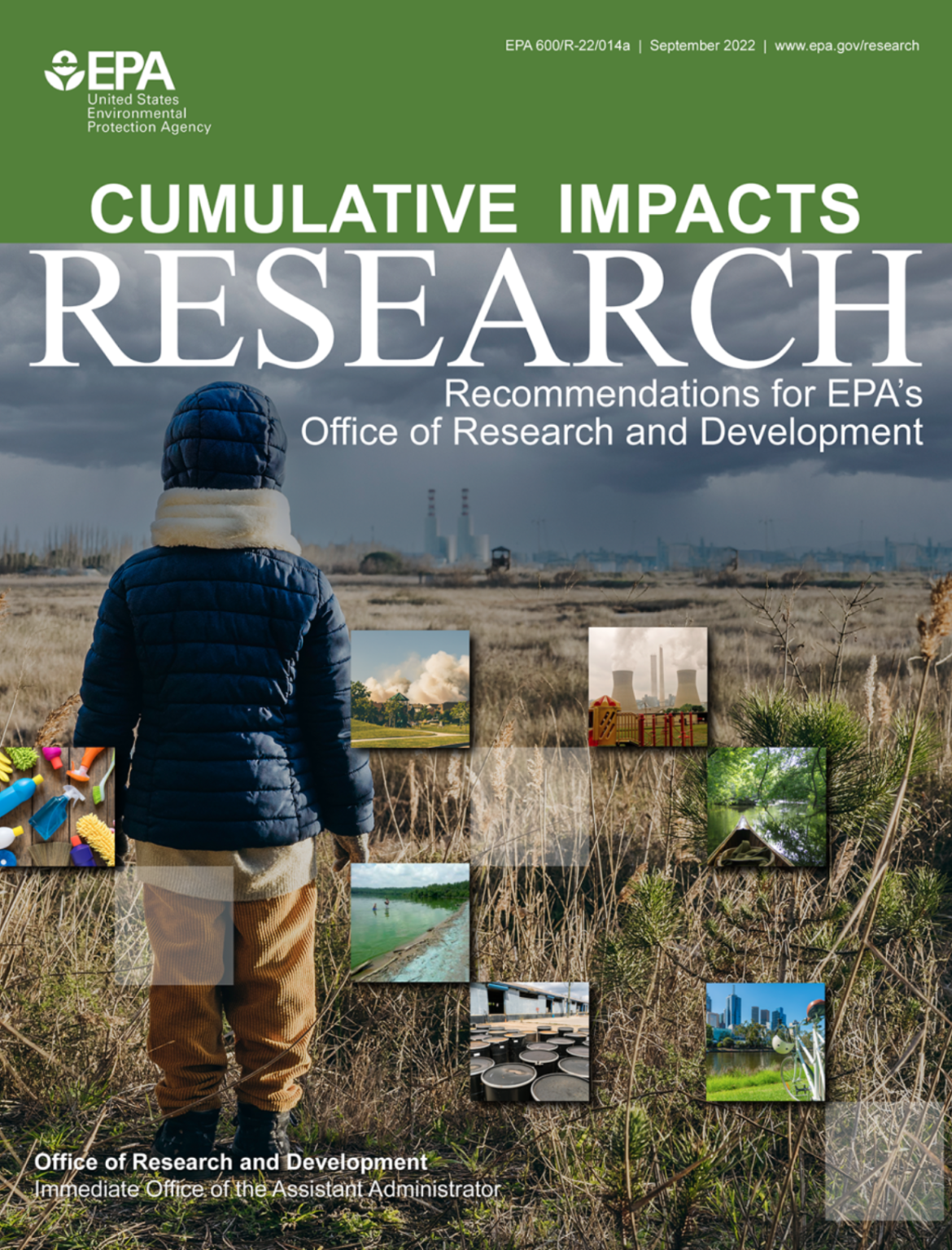EPA Provides Recommendations for Researching Cumulative Environmental Impacts

Exposures to pollutants in the environment, including in air, water, and soil, lead to adverse impacts to human health and the environment. These pollutants are also referred to as chemical stressors. There is growing recognition that other types of stressors, referred to as nonchemical stressors, also affect human health and wellbeing. These include socioeconomic disadvantages, lack of environmental assets (e.g., greenspace) in a community, and health vulnerabilities, Chemical and non-chemical stressors may accumulate over time from one or more sources. For example, studies have shown that there is an association between the 1930’s practice of redlining and the current location of urban heat islands, air pollution levels, and health disparities.
Cumulative Impacts and Environmental Justice
Cumulative impacts are the totality of exposures to combinations of chemical and non-chemical stressors and their effects on health, well-being, and quality of life outcomes. Cumulative impacts are a part of the larger conversation around environmental justice (EJ). In January 2021, President Biden signed Executive Orders (EO) 13985 and 14008 to advance racial equity and support for underserved communities and to address the climate crisis. These EOs provide a framework for stimulating action across the federal government to address health inequities in the United States caused by disproportionate exposures to pollution and environmental degradation that are exacerbated by racial, economic, and geographic factors and climate change.
In support of these Orders, EPA Administrator Michael Regan issued an Agency-wide directive in 2021 to take steps to better serve historically marginalized communities. This commitment is emphasized by EPA’s Equity plan and the Agency’s use of cumulative impact assessment, among other ongoing processes.
Cumulative Impacts Research in the Office of Research and Development (ORD)
EPA has identified the cumulative impact assessment as one means to address environmental injustice. In the newly publishedCumulative Impacts Research: Recommendations for EPA’s Office of Research and Development report, ORD defines cumulative impacts and shows the various research areas that can use this evolving concept. This research is essential to solving longstanding environmental health problems, including health disparities exacerbated by racial and social injustices. These issues can benefit from an accurate and realistic assessment of the effects from the combined exposures to inform decision-making at all levels, across communities.
“It is critical to bolster the scientific basis for identifying actions that can improve community health and well-being, and for selecting, implementing, and evaluating such actions,” said H. Christopher Frey, Ph.D., Assistant Administrator of EPA’s Office of Research and Development, in the report.
Preparing for a New Research Cycle
EPA’s Cumulative Impacts Scoping Workgroup (Workgroup) hosted in-depth engagements with EPA, states and tribes, and community representatives, and followed advice from National Environmental Justice Advisory Council (NEJAC) and the White House Environmental Justice Advisory Council (WHEJAC). To develop a foundation for detailed recommendations to advance the state of science for cumulative impacts assessment, the Workgroup identified gaps and barriers in cumulative impacts research. Key gaps include the identification and characterization of both chemical and non-chemical stressors; methods to conduct analyses of cumulative impacts; and lack of high-resolution data. Barriers include: missing skill sets and expertise in ORD; necessary partnerships with communities, tribes, and other governmental entities that require trust, resources, and/or agreements; and resource stability to plan and follow through on delivery of results.
Future Plans
The recommendations from the report are already informing actions within ORD. Cumulative impacts-related research is a cross-cutting priority for each of the Agency’s six National Research Programs (NRPs) and was included in the development of their respective Fiscal Years 2023-2026 Strategic Action Research Area Plans (StRAPs). The NRPs have integrated efforts to improve the understanding of cumulative impacts and to conduct real-world assessments of the cumulative impacts that result in both adverse and beneficial health and environmental effects. There are currently 94 products planned for the FYs 2023-2026 StRAP cycle that are associated with cumulative impact research across the NRPs. How each NRP is integrating cumulative impacts research into their programs is summarized below:
- Air, Climate and Energy (ACE): ACE research evaluates the complex health and ecological effects of exposures to pollutants as well as how the impacts of these exposures can be modified by co-exposures to other stressors (e.g., extreme temperatures, noise, social factors). In addition, ACE research investigates the cumulative effects of short- versus long-term exposures.
- Chemical Safety for Sustainability (CSS): CSS research will include a focus on exposure to chemical mixtures that will coverresearch to characterize mixtures of unknown composition as well as co-exposures to real-world mixtures; characterization of exposure to include investigation into how non-chemical stressors combined with chemical stressors may impact health outcomes; and efforts to evaluate health disparities that may arise from unequal exposures to chemicals.
- Health and Environmental Risk Assessment (HERA): HERA has predominantly focused on single chemical assessments and a smaller number of assessments of chemical mixtures. However, as the need for evaluating multimedia exposures that incorporate chemical and non-chemical stressor interactions has increased, HERA has focused research on cumulative risk assessment methods and practices.
- Homeland Security (HS): Through its focus on resilience equity, HS research will ensure that information and tools include the multitude of stressors impacting a community when used to support incident response. Resilience to an incident is directly influenced by the cumulative impacts of the incident and other stressors within a community.
- Sustainable and Healthy Communities (SHC): The SHC research portfolio takes a holistic view, considering the interactions between people and their surroundings or, more specifically, the relationship between the environment and human health and well-being. SHC research examines stressors from the built, natural, and social environments, including health benefits, such as the benefits that nature provides through ecosystem goods and services, and their impacts on human health and well-being.
- Safe and Sustainable Water Resources (SSWR): The SSWR’s research portfolio carries near- and long-term goals designed to yield practical tools and solutions for ensuring sustainable and equitable water resources. Research includes chemical mixtures bioassay research that supports the understanding and development of ambient water quality criteria critical to protecting aquatic ecosystems and human health, and tool development and risk management studies on exposures to contaminants in drinking water and the impacts of these stressors on health and well-being.
In addition to the research plans highlighted above, ORD has developed plans to include new skill sets and expertise as part of its hiring strategy to support our work on cumulative impacts, and to expand capabilities and capacity for collaborative and participatory research engagement with overburdened communities. ORD is prepared to do more as we implement cumulative impacts research in the years to come.
Learn More:
- Cumulative Impacts Research at EPA
- Cumulative Impacts Research: Recommendations for EPA’s Office of Research and Development (pdf)
- EPA’s Environmental Justice Equity Action Plan
- FY2023-2026 StRAPs
Definitions:
- Cumulative Impacts are defined as the totality of exposures to combinations of chemical and non-chemical stressors and their effects on health, well-being, and quality of life outcomes.
- Cumulative Impact Assessment is defined as a process of evaluating both quantitative and qualitative data representing cumulative impacts to inform a decision.
